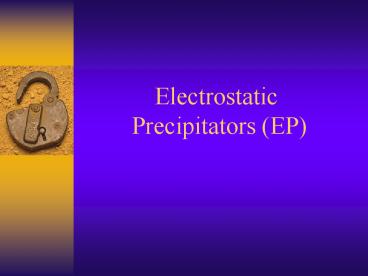Electrostatic Precipitators EP PowerPoint PPT Presentation
1 / 13
Title: Electrostatic Precipitators EP
1
Electrostatic Precipitators (EP)
2
Electrostatic Precipitators (EP)
- 1. High-voltage single-stage precipitators
operate in the 30,000 to 100,000-V range and are
used at large industrial plants such as
coal-fired utility boilers - 2. Low-m voltage precipitators have design
capacities approaching 10 m3/s (20,000 ft3/s),
with an air velocity of about 0.5 m3/s (100
ft3/s)
3
(No Transcript)
4
Electrostatic Precipitators (EP)
- 3. Electrostatic precipitators are extremely
efficient (99 or higher) for a wide range of
particle sizes even sub-micron-size particles - 4. Can handle large volumes of gas - 25 to 1000
m3/s (50,000 to 2,000,000 ft3/s) - have low pressure drops and operate continuously
with little maintenance
5
Electrostatic Precipitators (EP)
- 5. The size-efficiency relationship for an
electrostatic precipitator is a curvilinear
function similar to that for a cyclone - Efficiency 1- exp-(Aw/Q)
- A area of the collection plates, m2
- w drift velocity of the charged particles, m/s
- Q flow rate of the gas stream, m3/s
6
Principle of Operation
- (1) The removal of particles from a gas stream
by an EP depends on the fact that charged
particles in an electrostatic field will migrate
towards regions of opposite polarity. - (2) Uncharged particles entering the channels
receive a charge (usually negative) from the
electrodes or ionized gas and then move towards
the walls of the channel which are earthed.
7
(No Transcript)
8
Principle of Operation
- (3) For effective dust removal, the voltage
between the discharge electrode and collector
plates must be sufficient to achieve a stable
corona discharge but insufficient to cause
excessive sparking.
9
Principle of Operation
- (4) The required treatment time in an EP, and
consequently its size, depends directly on the
required degree of cleansing of the gas and the
physical properties of the dust. - (5) Particles of the dust attracted to the
earthed collector sheets form an agglomerated
layer on the surface which must be periodically
removed.
10
Method of cleaning
- Dry rapping
- Striking the surface of the collectors with a
hammer device - Continuous or periodic flushing with a liquid
(normally water) which usually results in a
slurry effluent
11
Resistivity
- Resistivity is a term that describes the
resistance of the collected dust layer to the
flow of electrical current. - Between 104 and 107 ohm.cm -- low resistivity
- Between 107 and 1010 ohm.cm -- normal resistivity
- Above 1010 ohm.cm -- high resistivity
12
Specific collection area
- The specific collection area (SCA) is defined as
the ratio of collection surface area to the gas
flow rate into the collector - SCA A / Q
- A Total collecting surface (sq. meter)
- Q Gas flow rate (cubic meter per hr)
13
Aspect ratio
- The aspect ratio (AR) is the ratio of the total
length to height of the collector surface. - AR effective length / effective height
- Have a EP many times larger in length than in
height would be ideal. However, space limitations
and cost could be prohibitive.

